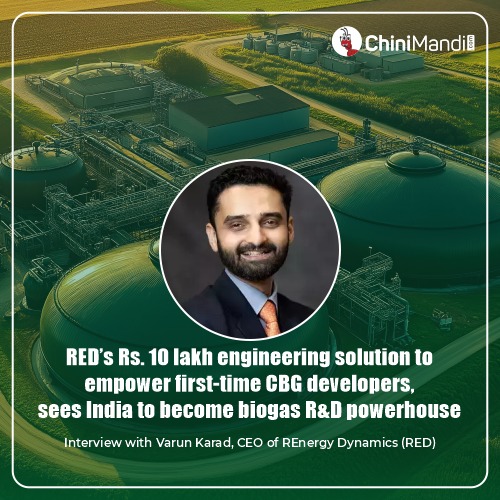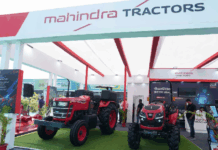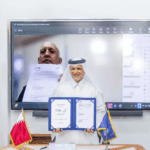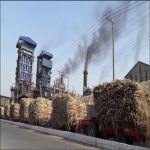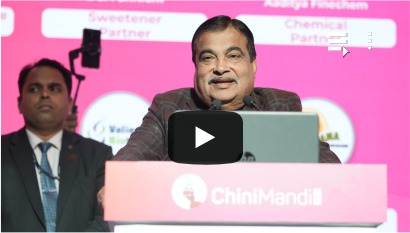With the launch of its specialized initiative offering comprehensive engineering services for small Compressed Biogas (CBG) plants (up to 3.5 TPD capacity/1 digester) at a cost of Rs. 10 lakhs, REnergy Dynamics (RED), a company dedicated to advancing the bioenergy sector in India, is addressing one of the biggest challenges in the biogas industry, project fragmentation. In an interview with our editor, Prakash Jha, Varun Karad, CEO of RED, sheds light on the company’s innovative approach to the CBG sector. He explained how the fully deployable, end-to-end engineering package is designed to streamline the process for first-time developers, SMEs, and rural entrepreneurs. From the feedstock aggregation to the integration of diverse waste inputs, he emphasized how RED’s solution offers a flexible yet standardized model that could revolutionize biogas plant deployments. As the company aligns with India’s ambitious SATAT initiative and sets its sights on deploying several plants in the first year, REnergy Dynamics’ CEO also discussed the future of biogas, from AI-driven optimization to India’s potential as a global biogas hub. In this conversation, he not only reflected on current market challenges but also highlighted the transformative potential of biogas in India’s sustainable energy landscape.
Offering a complete engineering solution at Rs. 10 lakh is an interesting move in the CBG sector. Could you tell us more about it?
We’ve designed this offering to eliminate the ambiguity and fragmentation that often slow down CBG projects in their early stages. Our Rs. 10 lakh (+GST) engineering solution delivers a complete set of civil, mechanical, electrical, and instrumentation engineering packages, tailored for a digester of up to 3.5 TPD CBG output. It’s a fully deployable foundation that sets the stage for quick, cost-effective implementation.
What inspired REnergy Dynamics to launch an end-to-end CBG plant engineering solution at such an affordable price point?
Our inspiration came from the field — from talking to first-time project developers, SMEs, and even progressive farmers who wanted to adopt biogas but were overwhelmed by complex vendor ecosystems, expensive consultants, or unclear execution paths. We believe good engineering should be accessible and implementation-ready, especially in a sector that directly supports sustainability, waste management, circularity, rural livelihoods, and energy independence along with energy access.
Was there a specific market gap or customer need that prompted the creation of this Rs. 10 lakh packages?
Yes, a very specific one. Many promising CBG projects fail at the conceptual or DPR stage due to a lack of integrated, technical planning. CBG, we believe is more about know-how than technology per se. And most developers lack awareness of this know-how, moreover, they receive piecemeal information from various consultants in an un-coordinated manner which ultimately has resulted in many cases as reported in unfavourably high EPC/Project cost. We saw the need for a pre-vendor-ready, standardized, yet flexible package that will help them achieve 80% of either requirement in terms of desired technology configuration, quickly and affordably.
How does this package differentiate REnergy Dynamics from other players in the CBG infrastructure and engineering segment?
Our approach is pure engineering services not limited to just consultancy offering, but a ready-to-deploy customized engineering solution with actual engineering drawings, P&IDs, 3D layouts, BOQs, feedstock aggregation logic, and even vendor alignment. We also ensure our designs are compliance-ready, keeping in mind statutory and safety norms from day one.
Who do you see benefiting the most from this package — is it aimed more at small entrepreneurs, farmers, or established players looking to expand into CBG?
All three, however especially focused on first-time developers viz farmer producer organizations (FPOs), cooperatives, SMEs with ESG mandates, and Agri-tech startups. Our offering will provide them with a solid technical backbone limiting the burden of hiring large engineering teams or relying on vague estimates. Established players can also use it as a base template to accelerate on ground adoption of new projects in smaller segment as well is in the test markets.
How many plants do you believe can be deployed using this model in the next 12 months?
REnergy Dynamics (RED) is actively contributing to India’s ambitious goal of establishing 5,000 Compressed Biogas (CBG) plants by 2030 under the Sustainable Alternative Towards Affordable Transportation (SATAT) initiative.
Our target is to facilitate deployment of 16-20 plants in the first-year working with direct clients in partnerships with NBFCs, government programs, and CSR-linked sustainability initiatives. If we look at the number of plants of smaller capacity upto 3.5 TPD registered on GOBAR Dhan portal, it presents a significant opportunity with more than 160 plants accounting for about 30% which are yet to enter into construction phase. We see it as an initiative which will have cascading effect on strengthening the market and acts as a confidence booster among various stakeholders.
How adaptable is this solution to different feedstocks—Agri waste, press mud, municipal waste and others? Or is it optimized for a specific input type?
It is both. The solution is modular and adaptable. The core design can handle diverse organic inputs such as press mud, dairy waste, poultry litter, food waste, and crop residue, provided the basic feedstock profile is shared with us as feedstock characteristics vary widely for various feedstock. There is no single solution or technology to handle diverse feedstock and hence mass balance and digestion strategy can be customized accordingly offering a truly multi-feedstock-compatible solution. Needless to mention, the cost and process optimization are the key components of our offering.
How flexible or customizable is this package depending on site conditions or client-specific needs?
Very flexible. While we maintain standardization to ensure speed and affordability, we also allow for location-specific customization such as plot shape, climate conditions, local construction norms, or integration with existing infrastructure. Think of it as 80% standard, 20% tailored, with optional add-ons.
With technology evolving rapidly, what’s the next major shift or innovation you expect in the biogas sector?
We anticipate a shift toward AI-driven plant optimization along with the application of advanced automation system, fault detection using machine learning algorithms, predictive maintenance scheduling, evolution of bio-CNG microgrids, and smart digesters with real-time monitoring via IoT ensuring operational efficiency and product quality. Another big change will be integrated nutrient recovery, where digestate is not treated, discarded, disposed-off just as waste but monetized as a tailored fertilizer product.
Do you think India has the potential to become a global hub for biogas innovation or technology exports in the coming years?
Absolutely. With our Agri diversity, government support, and growing awareness with regards to ESG across industries, India is uniquely positioned to become a biogas R&D powerhouse. We’re already seeing international interest in Indian plant designs, especially for low-cost, modular, rural-scale applications. However, industry needs to develop strong collaborations with multiple stakeholders including academia, equipment manufacturers, financial institutions, think-tanks, government department and agencies including policymakers to give impetus to R&D needs for the biogas sector as it can contribute immensely towards achieving targets and goals specific to energy production and consumption, waste management, circularity and decarbonization of the economy.
Do you see any challenge in India’s CBG sector?
Yes, on project development and operations front, mainly in execution consistency, finance access, and long-term O&M frameworks. Many plants underperform due to lack of proper engineering, poor O&M practices, or mismatched feedstock assumptions. That’s exactly the gap we’re working to address, by bringing predictable, well-documented, and replicable project planning into the mainstream. Holistically speaking, the sector is fraught with significant challenges hindering the development of overall market and ecosystem despite conducive policy environment. Some of the major challenges include pertains to feedstock availability, aggregation and collection efficiency; limited access to the grid for off-take, access to affordable finance and lack of fixed gas pricing mechanism which could be provided to at least a few hundred plants initially to give impetus to the CBG deployment.

